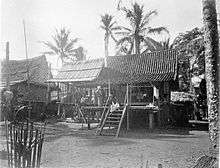Napal Licin
Napal Licin, sometimes written as Napal Litjin from the Dutch East Indies era, is a location in south Sumatra that was visited by European explorers at the end of the 19th century.[1] A cave in the area, Napal Licin Cave, features stalactites and stalagmites and is a tourist attraction that can be reached by boat up the Rawas River,[2][3] a tributary of the Musi River.

Henry Ogg Forbes reached Napal Licin during his expedition to central Sumatra. He described it as a picturesque village at the base of a perpendicular limestone peak, Karang-nata (Karang Nato). He climbed it, describing the caves with stalactites and thousands of bats he encountered, as well as ferns, orchids, and a species of Boea. He also found a species of nutmeg with fruit "as large as the largest orange". He also found ants "milking" a Hemipteron which produced droplets for them.[4]
Gallery
 Portrait of girl in Napal Litjin, Djambi Residency (Jambi) by Daniël David Veth (circa 1878)
Portrait of girl in Napal Litjin, Djambi Residency (Jambi) by Daniël David Veth (circa 1878) A native of Napal Litjin Palembang Uplands district Rawas Sumatra
A native of Napal Litjin Palembang Uplands district Rawas Sumatra "Batang Koeloes" at Napal Litjin district, Rawas, Sumatra
"Batang Koeloes" at Napal Litjin district, Rawas, Sumatra Man and boy in Napal Litjin
Man and boy in Napal Litjin A rope spinner
A rope spinner A girl
A girl
See also
- Theloderma licin, a species of frog
- Musi Rawas
- Kerinci Seblat National Park
References
- Journal of the Asiatic Society of Bengal, Volume 66 Asiatic Society (Kolkata, India 1897 page 471
- Napal Licin Cave South Sumatra Tourism
- Napal Licin Cave Indonesia Tourism
- A naturalist's wanderings in the Eastern archipelago: a narrative of travel and exploration from 1878 to 1883 Henry Ogg Forbes, Harper & brothers, 1885 page 250, 251, 279